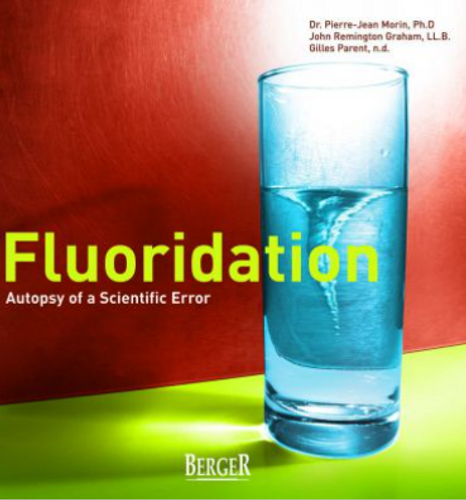Fluoride Harm: Suppressed Science and Silenced Voices
by Dr Hardy Limeback (Author, Editor), Dr Joseph Ladapo (Foreword), Karen Favazza Spencer (Editor)
Includes 36 chapters from internationally recognized scientists, medical professionals, journalists, and citizen advocates—including Erin Brockovich and Dr. Paul Connett, PhD of the Fluoride Action Network. It covers a range of fluoride issues, including sulfuryl fluoride used as a pesticide in food production.
This book is not intended to be a detailed scientific treatise on fluoride, although scientific evidence of harm and doubts about benefit have been expressed by most of the chapter contributors. Primarily, it is a collection of personal accounts from people who have suffered discrimination, ridicule, and personal attacks because of their advocacy to reveal the harm that fluoride does to people.
Edited by Dr. Hardy Limeback, BSc, PhD, DDS and Karen Favazza Spencer, Fluoride Harm begins with a foreword by Dr. Joseph Ladapo, MD, PhD, the Surgeon General of Florida. This groundbreaking collection of testimonies detailing deceits and politics reveal how fluoride became one of the most controversial and least transparent public health practices in modern history. Each of the contributors to this anthology are well versed on both sides of the fluoride controversy. They oppose the intentional fluoride exposure of the general population without the express consent of the individual.
Some of the authors are fluoride-injured and all of them have paid a price for their commitment to speaking the truth to power. Their personal, multi-year efforts to end the routine poisoning of community water supplies with arsenic-contaminated fluoridation chemicals, chemical byproducts collected from the smokestacks of phosphate fertilizer plants and other industries, have resulted in lost jobs, lost friendships, and lost sleep. But their efforts have helped regain the health of those who have listened and have moved scores of communities as well as two states in the US, so far, to ban water-fluoridation schemes.
Understanding the depth and breadth of the corruption among regulatory, medical, and dental authorities, whose loyalty is for sale, is disheartening. Taking action to prevent your brain, body, and bones from being poisoned for the financial benefit of stakeholders committed to a dental mythology is empowering.
Chapter & Authors
1Dr David Kennedy, IAOMT dentist
2 Melissa Gallico, author
3 Dr Richard Shames & Dr Karilee Shames, thyroid experts
4 Brenda Staudenmaier, water works trainer
5 Dr Robert C. Dickson, family physician
6 Erik E. Crown, filmmaker
7 Erin Brockovich, environmentalist & Bob Bowcock, watermaster
8 Dr C. Vyvyan Howard, toxicopathologist
9 Michele Paduano, former BBC journalist
10 J. William Hirzy Jr., EPA union president
11 Dr E. Griffin Cole, IAOMT dentist
12 Andy Anderson, Ozark water authority board chair
13 Dr Bill Osmunson, public health dentist
14 Aliss Terpstra, activist
15 Brent Foster, attorney
16 Dr Mark Diesendorf, Environment & Society prof.
17 Audrey Adams, activist
18 Dr Hardy Limeback, prof. emeritus, dental researcher
19 Carol Kopf, activist
20 Dr Paul Connett, Fluoride Action Network
21 Mary Byrne, activist
22 Declan Waugh, environmental health risk scientist
23 Dr Deborah E. Moore, activist
24 Dr Brian Martin, emeritus professor of social sciences
25 Dr Hardy Limeback (about Dr Christine Till)
26 Dr Kathleen Thiessen, Sr. Scientist Oak Ridge Center for Risk Analysis
27 John Mueller, Sr. Engineer Tulsa Water & Sewer Dept (ret.)
28 Dr Bruce Spittle, psychiatrist, ed. journal Fluoride
29 Lynn Campbell, activist
30 Dr Gilles Parent, naturopathic doctor
31 Douglas Cragoe, videographer-activist
32 Ellen Connett, Fluoride Action Network
33 Derrick Broze, author-journalist
34 Clint Griess, activist
35 Karen Favazza Spencer, analyst-activist
36 Daniel G. Stockin, public health advisor
RESPONSES TO CLAIMS OF CAVITY INCREASES IN
CALGARY, JUNEAU AND WINDSOR FOLLOWING FLUORIDATION CESSATION
Fluoridation promoters often tout statistics claiming cavity rates went up in Calgary, Alberta; Juneau, Alaska and Windsor, Ontario because they stopped fluoridating.
Here’s what they’re NOT telling you, which debunks arguments for all three:
Calgary
-
A 2016 study (McLaren et al https://www.sciencedirect.com/science/article/pii/S0033350616304656?via%3Dihub) concluded that cavity rates in baby teeth (not permanent teeth) went up in children because Calgary ended fluoridation in 2011.
-
But a 2017 academic commentary to the study (Neurath et al https://www.sciencedirect.com/science/article/pii/S0033350616304656?via%3Dihub) showed that cavity rates were going up just as much before Calgary stopped fluoridating in 2011 as after.
-
Stopping fluoridation made no difference whatsoever in the cavity rate increase.
Juneau
-
A 2018 study (Meyer et al https://pubmed.ncbi.nlm.nih.gov/30545358/) concluded that cavity rates went up in children because Juneau ended fluoridation in 2006.
-
But the study never measured cavity rates, only the increase in Medicaid-funded dental costs, claiming those increased costs represented an increase in cavities. The two are not the same.
-
It never controlled for two major factors that could have accounted for all these increases in Medicaid use:
-
A large increase in the number of children enrolled in Medicaid
-
A large increase in Medicaid funding to dentists in 2008 and 2009, which increased the number of dentists accepting Medicaid patients
-
-
In short, more kids + more dentists = more Medicaid costs for treatment of cavities, NOT more cavities.
Windsor
-
A 2018 survey by Windsor-Essex County (https://www.wechu.org/reports/oral-health-2018-report) conducted by dental hygienists concluded that cavity rates went up in children because Windsor ended fluoridation in 2013.
-
But numerous variables that contribute to cavity increases were never considered, including a large influx of low-income immigrants and refugees in the study period. Windsor experienced the worst average-income drop in Ontario, and low-income families are known to have higher cavity rates.
-
The survey also said the percent of cavity-free children went down. But the percentage of cavity-free children decreased as much before Windsor ended fluoridation as after. Stopping fluoridation made no difference whatsoever.















